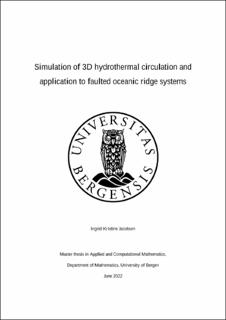| dc.description.abstract | Hydrothermal circulation in locations close to oceanic spreading ridges gives dissolved minerals from the crustal rock a chance to reach the seafloor. Temperature is increasing steadily with depth, heating water which resides within the permeable and faulted crust. At sufficient permeability, this causes the fluid to rise due to a lower density, allowing for dissolved minerals from the surrounding rock to be convected upwards. Natural convection in porous media heated from below is a thoroughly studied field, and we have studied this for faulted domains with parameters representative for the subseafloor. We have numerically solved the fully coupled conservation equations for fluid volume and energy with code based on tools from the open-source Python framework PorePy. The 3D domain where the equations have been solved are represented as a mixed-dimensional domain, where the porous rock, faults and fault intersections are treated as individual subdomains. The key concept behind a mixed-dimensional domain is that the different subdomains have different dimensions, meaning that within a 3D rock, the faults will be 2D, and fault intersections are 1D. Verification of the code has been done by confirming consistency in solutions with different initial conditions, and by numerical benchmarking against theoretical critical Rayleigh numbers for three different 3D domains. For fluid flow in faulted domains, it is expected that the fluid mainly flows through the faults as they are more permeable than the surrounding rock, and this is confirmed by the simulations. The results also present clearly how convection patterns are greatly impacted by different permeability ratios between the faults and the host rock, which may motivate further research considering layered or anisotropic porous media. The presence of faults is shown important for occurrence of hydrothermal convection in locations containing less permeable rock. Hence, the thesis illustrate how simulations can aid in understanding of governing processes for fluid circulation and transport of minerals in the subseafloor. | |
